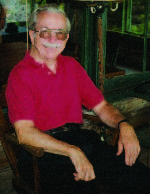Obituary - James R. Holden (1929 - 2003)Obituary | Publications | Curriculum Vitae | Videos | Slides | Articles James R. Holden (1929 - 2003)ACA RefleXions, Fall 2003
James R. Holden, 74, formerly of Adelphi, Md., died Sunday, July 20, 2003, in Brunswick, Maine in a hospital not far from his retirement home which he designed and had built in Phippsburg. His decline in health was sudden, and he died peacefully, surrounded by his immediate family. He received a Bachelor of Science and a master’s degree from the University of Nebraska and earned a doctorate in chemistry from the University of Iowa under N. C. Baenziger. He was a member of Phi Beta Kappa, Phi Mu Epsilon, Phi Lambda Upsilon, and Sigma Xi in recognition of his academic accomplishments. His 33-year professional career was with the Department of the Navy, Naval Surface Warfare Center in White Oak, MD, originally called The Naval Ordnance Laboratory, where he worked in the Energetic Materials Division. He was honored with the Navy’s Meritorious Civilian Service Award. Jim Holden was a highly respected scientist and was knowledgeable about many things outside his immediate field of expertise. He stayed out of the limelight at NOL/NSWC, but his steady, insightful advice was often sought by his peers and by NOL management as well. He published extensively, specializing in the determination of molecular structures by x-ray diffraction and the derivation of relationships between molecular structure and physical and explosive properties of organic compounds. Compounds such as 1,3- Diamino-2,4,6-trinitrobenzene were determined by analysis of Patterson functions, but later he successfully applied direct methods to structure determination. More than 20 polynitro aromatic compounds were determined in his laboratory, and this work led to a publication on the relationship between bond lengths and angles in these compounds. As part of the effort to determine these structures he contributed programs to the XRay/XTAL system being developed at the University of Maryland in that era. In addition to his structure determination work he contributed to a number of government patents. Then, in more recent times, continuing via the Internet after his retirement from the NSWC, he worked on the ab initio prediction of crystal structures of energetic materials, the MOLPAK and ROTPAK programs, in collaboration with Herman Ammon of the University of Maryland. He remained active in this work until shortly before his final illness. Probably his greatest contribution was his empirical method for estimating densities of organic compounds. This effort was driven by the importance of density in predicting the performance of explosives. Before his work there were just two relatively inferior methods for predicting explosive performance. Charlie Dickinson explained that: “Before this contribution the synthesis guys pretty much worked on instinct.” Jim, and his colleague Tom Hall, are the authors of The Navy Explosives Handbook, a compendium that is one of the major national references on explosive properties. In addition to his structure work, he also contributed to studies which produced phase diagrams of explosive materials. Jim was also a wonderful colleague to work with and a very thorough person. John Hoffsommer summed it up this way: “I have known Jim for a little over 44 years and consider him one of the finest human beings I have ever known. Jim was always very patient with me and took me step-by-step through the procedures necessary to make x-ray crystallographic measurements. What a wonderful mentor, teacher and friend Jim was!” This sentiment was reinforced by colleagues Ruth Doherty and Lore Kayser who wrote: “Friends like Jim Holden, very special people, don’t come along often in a person’s lifetime - so when they do, treasure them!” Survivors include his wife of nearly 45 years, Rachel “Daphne” Blachly Holden; two daughters, Carol Holden of Ann Arbor, MI, and Barbara Holden Newman of Bethesda, MD; and four grandsons. Jim was a caring and loving father and husband and will be sorely missed. His daughter reported that he was also a scientist to the end, signaling with his hands and eyes to ask about the nature of the sickness that took him. - Horst Adolph, Herm Ammon, Charlie Dickinson, Ruth Doherty, John Hoffsommer, Lore Kayser, and Jim Stewart |

